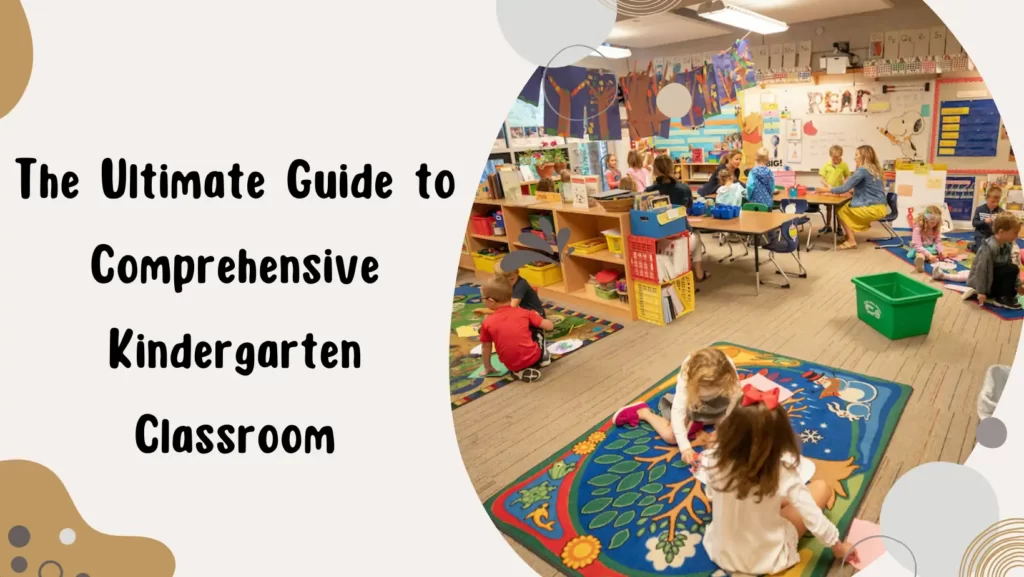Welcome to the ultimate guide on creating a comprehensive kindergarten classroom. Whether you’re a teacher, a parent, or an administrator, this article aims to provide you with valuable insights and tips to ensure a nurturing and effective learning environment for young learners.
Kindergarten is a key stage in a child’s education and the foundation for future learning. Learning letters and numbers alone is also key to developing curiosity, creativity and social skills.Creating the ideal kindergarten classroom involves understanding the unique needs of young learners.
In this guide, we will explore a range of topics, including classroom setup, engaging activities, effective teaching strategies, and promoting cognitive and social-emotional development. From creating inviting learning corners to incorporating play-based learning approaches, you’ll discover practical ideas to make your kindergarten classroom a lively and enriching space.
Join us as we embark on this journey to construct a comprehensive and captivating kindergarten classroom that supports the growth and development of every child. Are you ready to transform your classroom into a thriving hub of learning excitement? Let’s get started!
What a Great Kindergarten Classroom Looks Like?
A great kindergarten classroom is more than a room with tables and chairs; it’s a vibrant ecosystem that nurtures young minds. It should be a place where curiosity is ignited, creativity is encouraged, and learning is a joyful adventure.
Key aspects include:
- Aesthetic Appeal: Bright, cheerful colors and child-centric themes make the environment welcoming and engaging.
- Functional Design: The layout should promote easy movement and accessibility, with clearly defined areas for different activities.
- Safety and Comfort: Safety is paramount. Furniture and equipment must be age-appropriate and meet safety standards.
- Interactive Learning Zones: Areas designated for reading, arts, and interactive play support varied learning styles and needs.
- Technology Integration: Smart use of technology can enhance learning experiences, making them more interactive and inclusive.
Factors to Consider for Your Kindergarten Classroom
Designing a kindergarten classroom is a complex task that requires careful consideration of various key factors. Each element plays a significant role in creating an environment conducive to learning and growth.
Space Utilization
The classroom should have open areas for group activities balanced with quieter, cozy corners for individual learning. This arrangement facilitates various teaching methods and learning styles.

Child-Centric Design
The classroom design must cater to the physical and cognitive needs of young children. This includes selecting age-appropriate furniture and learning materials that are engaging and accessible to little learners.
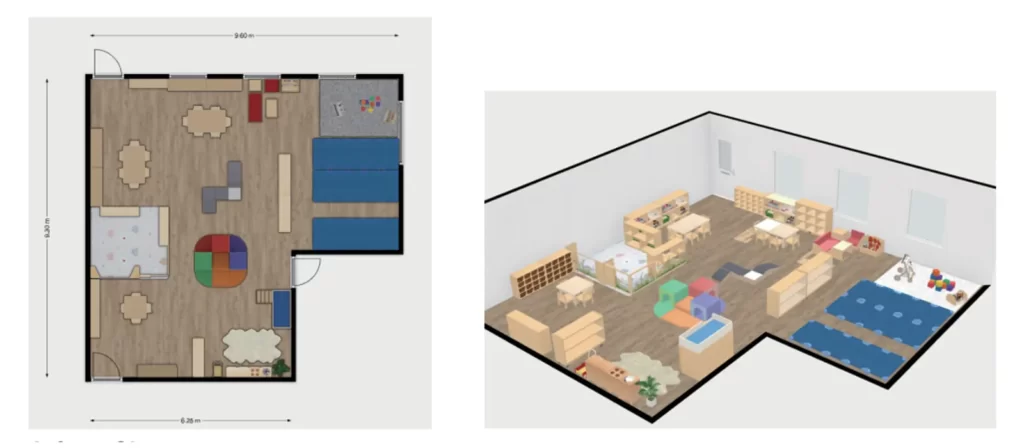
Flexibility
The classroom should be adaptable, allowing easy reconfiguration to suit different activities and teaching methods. This flexibility helps in accommodating diverse learning experiences and student interactions.
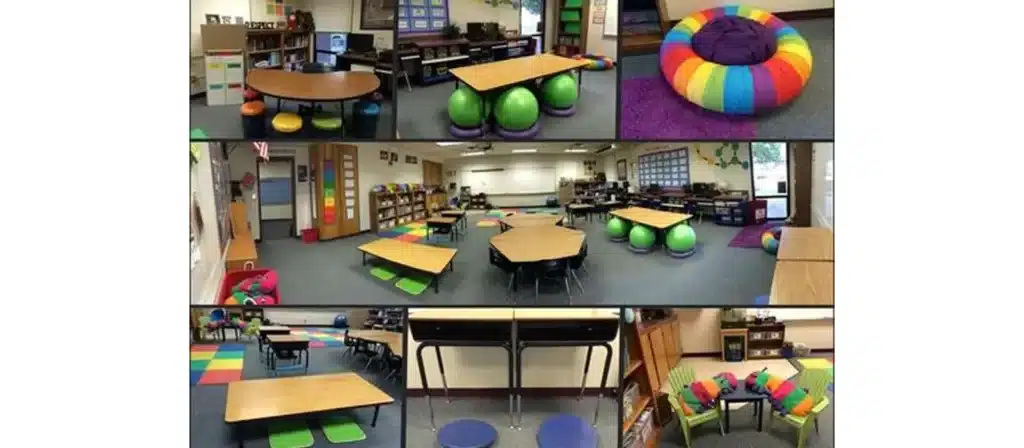
Cultural Inclusivity
The classroom environment should reflect and celebrate cultural diversity, fostering an atmosphere of inclusivity and mutual respect.
Safety
Safety is paramount in any kindergarten setting. This includes ensuring that all furniture and equipment are child-safe, non-toxic, and meet relevant safety standards. Emergency procedures should be clearly outlined and easily accessible.
Traffic Patterns
The layout should facilitate easy movement around the classroom. Consider the flow of traffic to minimize congestion and ensure that children can move safely and freely between different areas.
Furniture
Kindergarten classroom furniture should be ergonomically designed for young children to ensure comfort and promote good posture. It should be sturdy, safe and appropriate for the size of the age group.





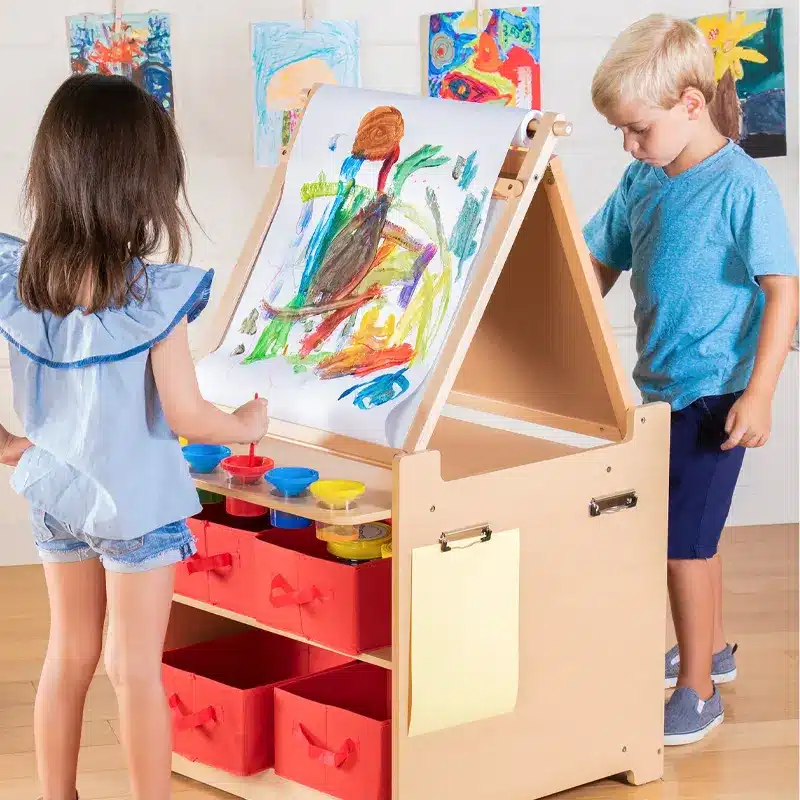
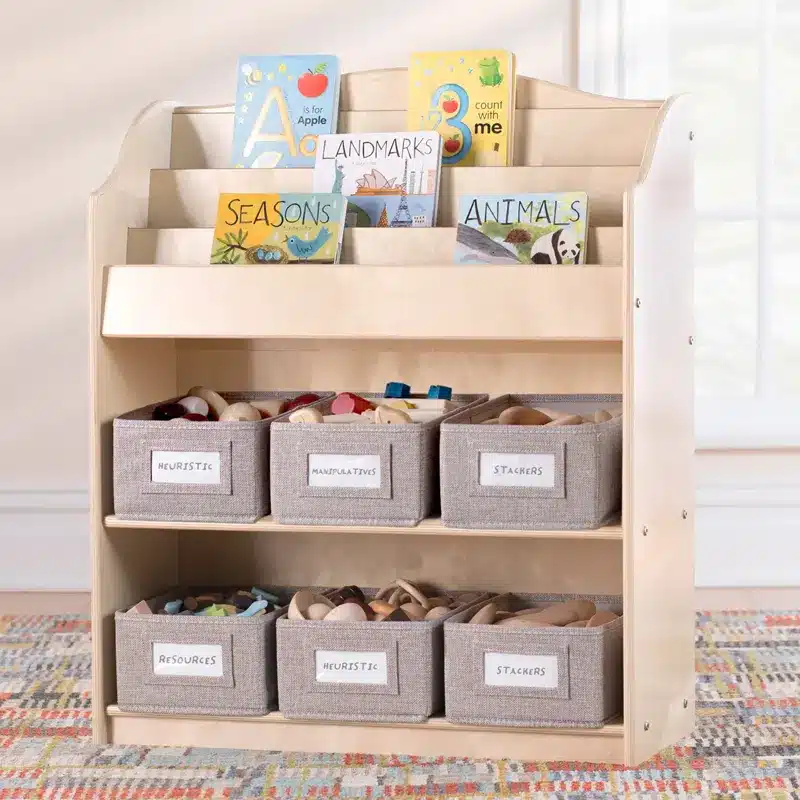
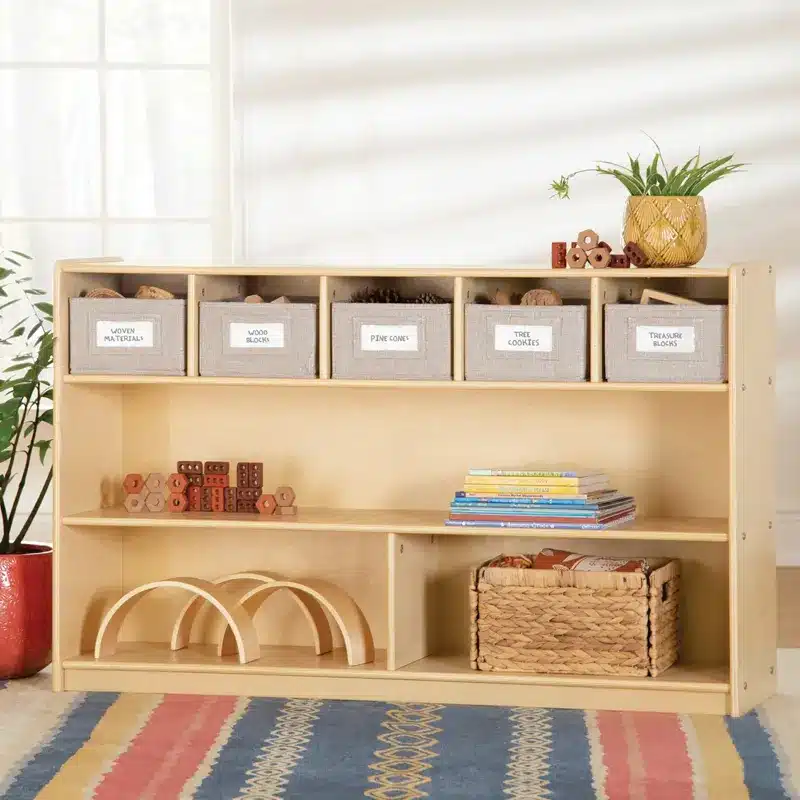
Materials
Select materials that are durable, easy to clean, and suitable for young children. This includes everything from toys and books to art supplies and educational aids.
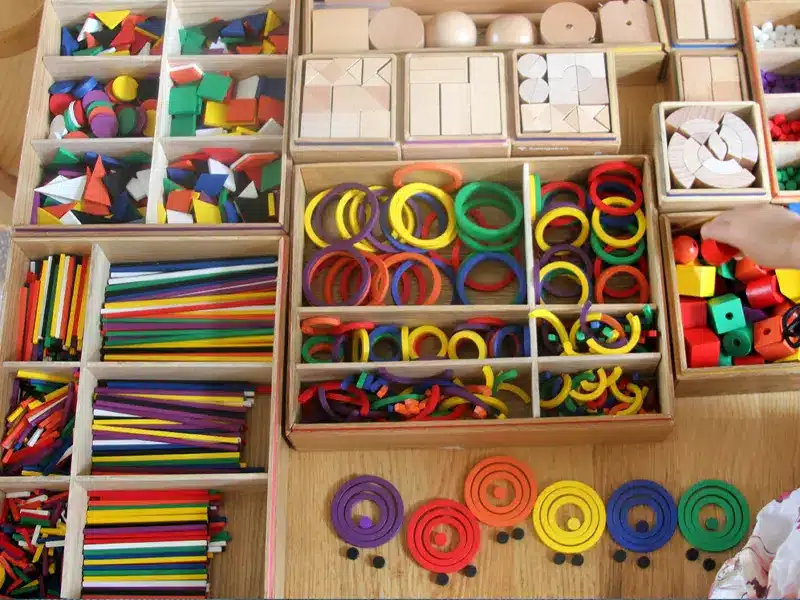

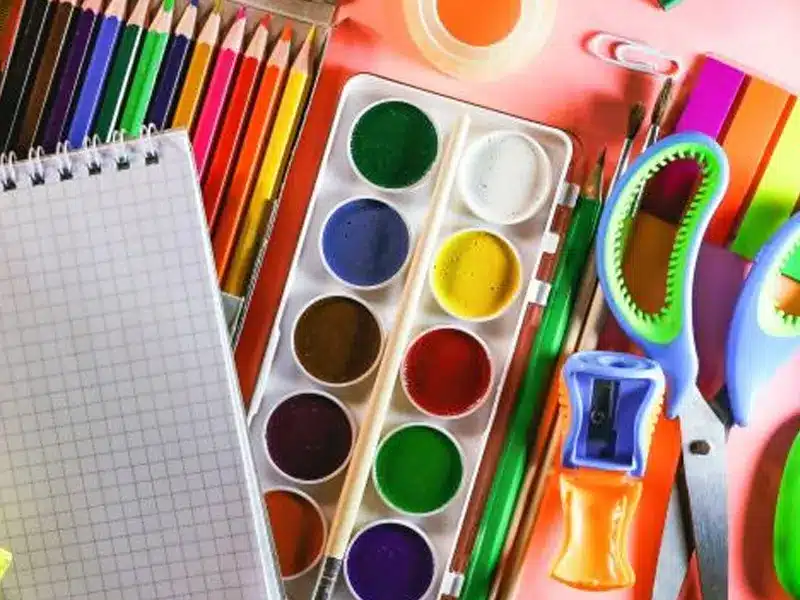
Organized Storage
Adequate and well-organized storage solutions are essential. They help in maintaining an orderly environment and make it easier for children and teachers to find and store materials.
Classroom Display
The kindergarten classroom should have areas for displaying children’s work, educational materials, and decorative items. These displays should be engaging and relevant to the children’s learning experiences.
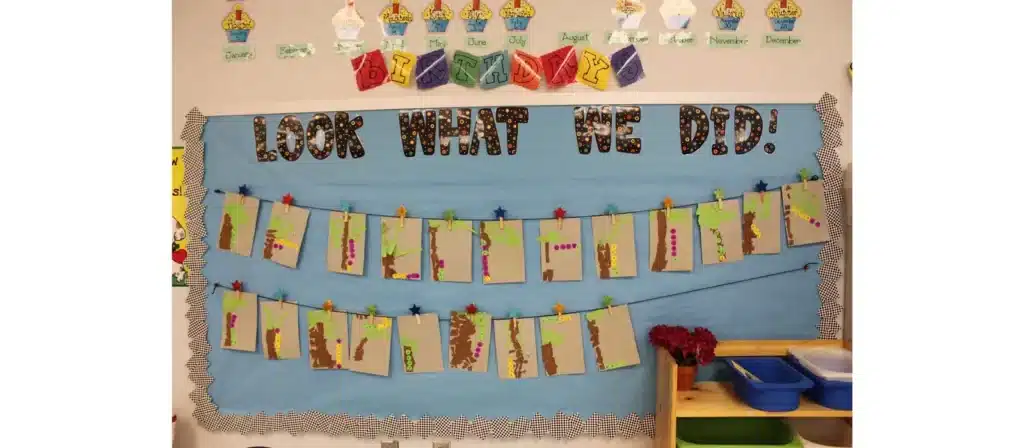
Planning Your Kindergarten Classroom
The planning of the kindergarten classroom should be at the forefront, you need to consider the rules of the classroom, the layout of the classroom area, the furniture needed for the classroom as well as the essentials.
Kindergarten Classroom Rules
Effective classroom management starts with a clear set of rules. In a kindergarten setting, these rules need to be simple, consistent, and positively framed to promote a safe and respectful environment.

Establishing the Rules
- Involve the Children: Involving children in the rule-making process can be beneficial. It gives them a sense of ownership and understanding of why rules are important.
- Keep it Simple: Rules should be easy to understand. Use simple language and concepts that kindergarteners can grasp.
- Limit the Number: Too many rules can be overwhelming. Stick to a few key rules that cover the most important aspects of classroom behavior.
Key Rules to Consider
- Respect Each Other: This includes using kind words, listening when others are speaking, and being considerate of others’ feelings.
- Share and Take Turns: Promote sharing and taking turns during activities. This fosters a sense of fairness and cooperation.
- Follow Directions: Encouraging children to listen and follow directions helps in maintaining order and ensures that activities run smoothly.
- Keep Hands to Yourself: This rule helps in preventing conflicts and ensures that everyone feels safe and comfortable.
Reinforcing the Rules
- Consistent Enforcement: Consistency is key in rule enforcement. Children should know that rules are always in effect and apply to everyone.
- Positive Reinforcement: Recognize and praise good behavior. This encourages children to follow the rules and sets a positive tone in the classroom.
- Visual Reminders: Having the rules displayed visually in the classroom can serve as constant reminders. Use pictures and simple words to illustrate each rule.
- Role-Playing and Scenarios: Use role-playing to demonstrate the importance of following rules. This makes learning about rules interactive and fun.
- Discuss Consequences: It’s important for children to understand the consequences of not following the rules. This should be done in a way that is understandable and not frightening.

Adapting Rules for Individual Needs
- Understanding Differences: Recognize that some children may have specific needs or challenges that require adaptation of certain rules.
- Flexible Approach: Be willing to adjust rules as needed. For example, a child with sensory processing issues might need a different approach to the ‘keep hands to yourself’ rule.
- Communication with Parents: Keep open communication with parents about classroom rules and any adaptations made for their child. This ensures consistency between home and school.
Reviewing and Updating Rules
- Regular Review: Periodically review the rules to ensure they are still relevant and effective. Get feedback from children and other educators.
- Making Adjustments: Don’t hesitate to adjust the rules if they are not working as intended. The goal is to create the best learning environment for the children.
- Celebrating Success: Acknowledge when the class as a whole is doing well in following the rules. Celebrations can be simple acknowledgments or small rewards.
Setting up your kindergarten classroom ideas
Reading Area
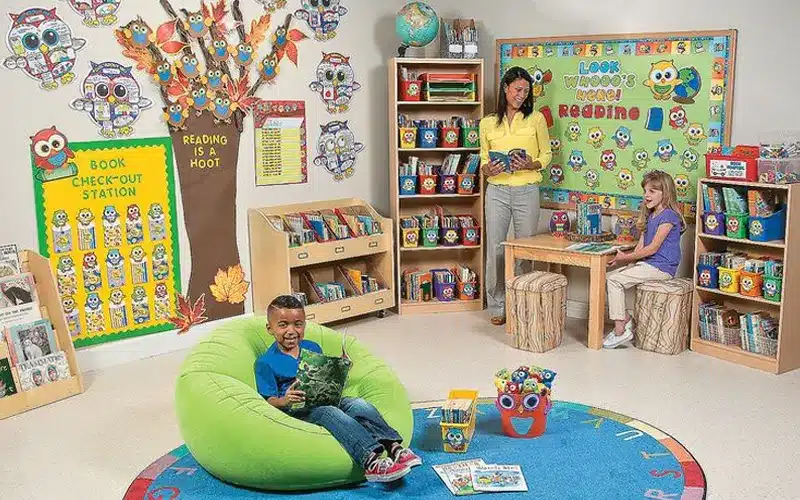
A reading corner in a kindergarten classroom helps children with early literacy.This area should be comfortable and pleasant, with cozy seating such as beanbags or cushions. Child-height bookshelves allow easy access to a range of books.
The decor of the reading corner plays a significant role. Soft colors, fairy lights, or themed decorations can make the space inviting. Including a variety of books, from picture books to simple readers, caters to different reading levels and interests.
Interactive elements like a story-telling chair or a puppet stand can enhance the reading experience, making it more engaging and enjoyable for the children. Regularly rotating the books and materials in the reading corner keeps it fresh and interesting for the students.
Whiteboard or Chalkboard Area

The area where the whiteboard or chalkboard is placed should be easily visible from all parts of the classroom and accessible to both teachers and students. Whiteboards or chalkboards can be used for everything from teaching letters and numbers to hosting group activities and drawing sessions.
Surrounding this area with educational posters, magnetic letters, and numbers enhances its utility. For a more dynamic experience, integrating a smartboard can bring digital elements into classroom teaching, making learning more engaging and interactive.
It’s important to ensure that the whiteboard or chalkboard is at a suitable height for children to interact with and is safe, with smooth edges and secure mounting.
Emergency Exits
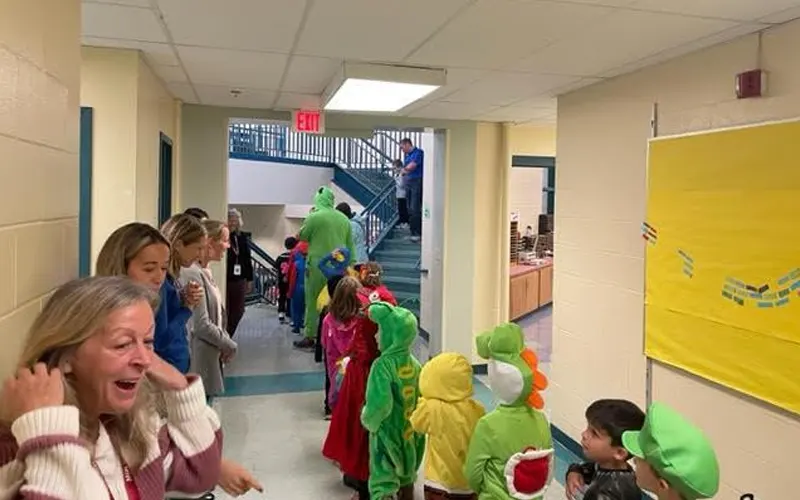
Safety is paramount in any classroom environment, especially in kindergarten. Emergency exits must be clearly marked, unobstructed and easily accessible. Regular safety drills and familiarization of children with emergency procedures are needed.
The area around the emergency exits should be free of clutter. Safety equipment like fire extinguishers should be in close proximity but out of reach of children. The exits should be part of the natural flow of the classroom, ensuring a quick and orderly evacuation if necessary.
Decorating the paths to emergency exits with educational or calming visuals can integrate these areas into the classroom environment while still maintaining their primary function of safety.
Wall Textures

Wall textures in kindergarten classroom can be both tactile and visual learning aids. Using materials such as cork board, fabric or foam can create an interactive surface for children to touch and explore.
Murals or themed wallpapers can transform the classroom into an immersive learning space, whether it’s a jungle scene, an underwater adventure, or a space exploration. These visuals can stimulate imagination and make the learning process more enjoyable.
Incorporating educational wall textures, such as an alphabet texture wall or a number touch-and-feel wall, can also be beneficial. These resources make learning more hands-on and interactive.
Bulletin Boards
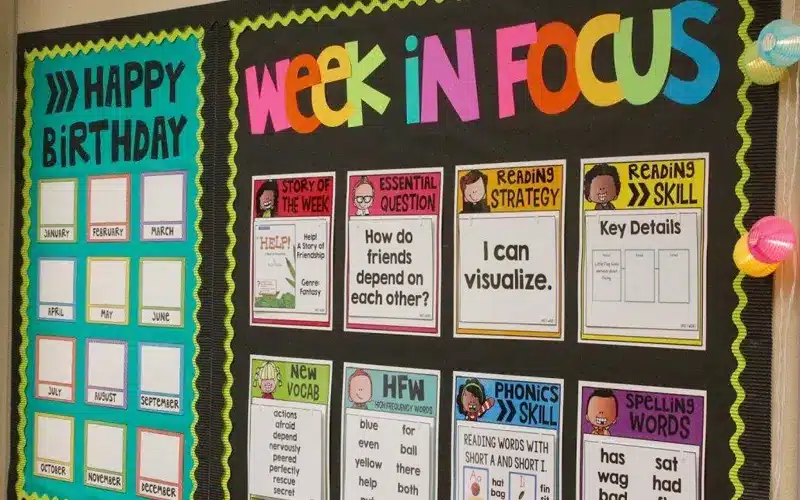
Bulletin boards are a dynamic component of any kindergarten classroom. They serve as a platform for displaying children’s artwork, educational materials, class schedules, and thematic decorations. Placing bulletin boards at child height allows children to interact with and take pride in the displayed items.
Keep the content fresh by changing it regularly. Involving children in the creation and setup of bulletin board content can be a fun educational activity that fosters creativity and ownership.
Using bulletin boards to highlight themes, seasons, or projects aligns with the curriculum and makes the learning experience more tangible. They can also be used to showcase class rules, student achievements, or upcoming events, serving as a visual and interactive communication tool.
Space for Group Lessons
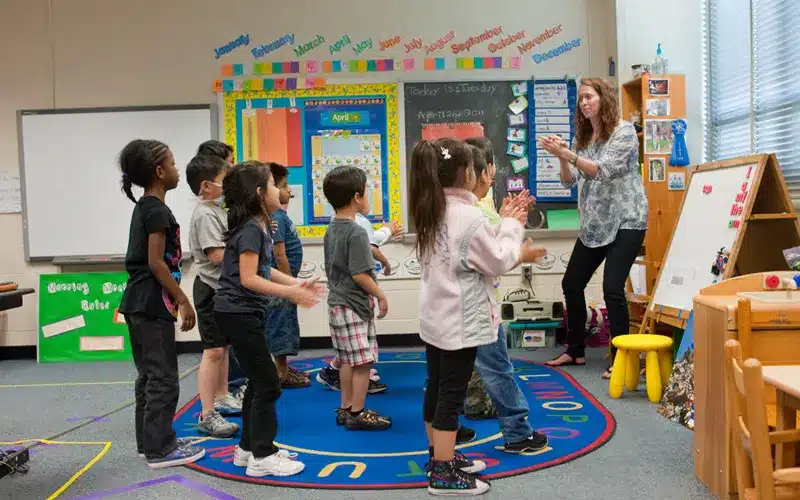
A dedicated space for group lessons is essential in a kindergarten classroom. This area should be spacious enough to accommodate the whole class comfortably for activities like story time, group discussions, or collaborative projects.
The layout should be flexible, allowing for different configurations such as a circle, rows, or small groups. This flexibility supports various teaching methods and activities. Having portable seating like mats or cushions can make rearranging the space easier and more fun for the children.
Drama Play Area

A drama play area in a kindergarten classroom encourages imaginative play and social interaction. This area can be equipped with costumes, props, and a small stage or puppet theater. It provides children with opportunities to express themselves, act out stories, and develop communication skills.
Where children are free to explore different characters and scenarios. Include a variety of costumes and props representing different cultures, occupations and roles to promote diversity and inclusion.
Incorporating Technology
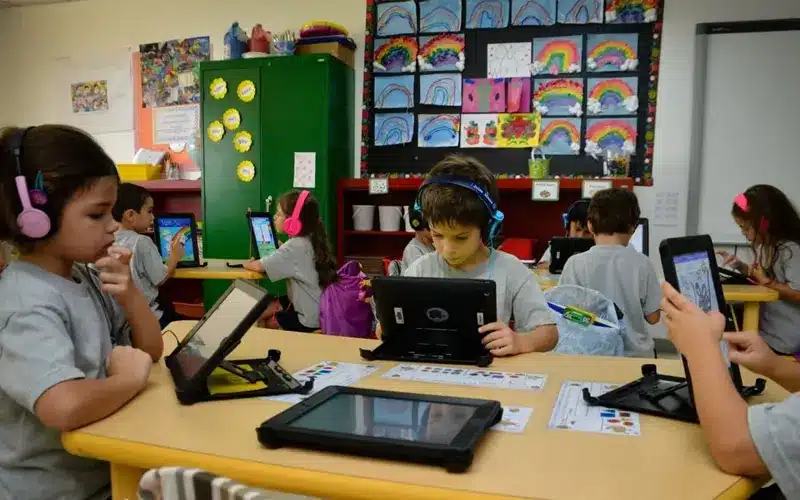
Interactive tools such as tablets or smart boards in kindergarten classroom can be powerful aids in engaging children in interactive and multimedia learning experiences.
Technology should be used to supplement traditional teaching methods, not replace them. It should be age-appropriate and used in moderation with close supervision. Educational apps and digital storytelling can be part of a balanced approach to learning.
Equipment and Furniture Needed for Kindergarten Classroom
Setting up a kindergarten classroom requires careful consideration of various equipment and furniture to ensure a conducive and safe learning environment for young learners.
Essential items for a kindergarten classroom range from basic furniture like tables and chairs to specific educational tools like a calendar wall, art supplies, and age-appropriate toys. Ensuring the availability and organization of these elements is key to an effective learning space.
1.Calendar Wall
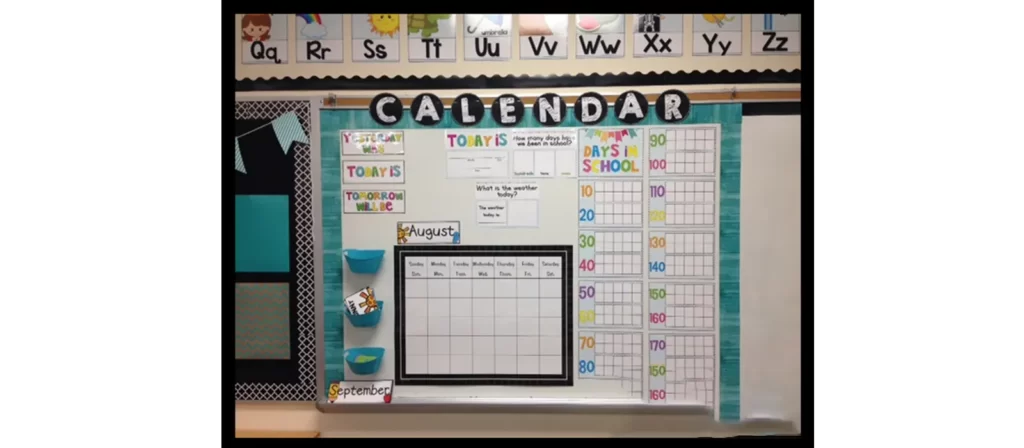
A calendar wall in a kindergarten classroom is more than just a tool for teaching days and months; it is an interactive educational aid. It has removable pieces on it to mark days, weeks, and special events. It helps children understand the concept of time and familiarizes them with the rhythm of the school year.
Weather elements such as symbols for sunny, rainy or snowy days can be added to the calendar wall, and seasonal themes can be integrated into the calendar wall to change with the months to reflect holidays, seasons and cultural events.
2.Kindergarten Classroom First Aid Kit
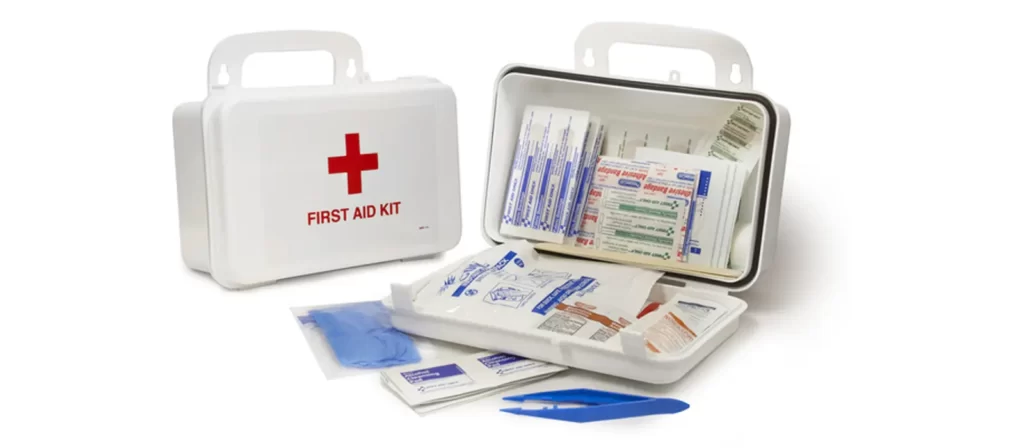
A well-stocked first aid kit is essential when dealing with minor injuries and emergencies in a kindergarten classroom. A first aid kit should include the following basic supplies:
- First Aid Guide
- Absorbent Dressings
- Adhesive Tape
- Antibiotic ointment
- Disinfectant wipes
- Aspirin
- First aid blanket
- Ice packs
- Non-latex gloves
- Sterile gauze
- Roller Bandage
- Sterile Gauze Pads
- Thermometer
- Tweezers
- Band-Aids
- Emergency contact list
The first aid kit should be stored in a known, easily accessible, yet secure location within the classroom. Regular checks are necessary to replace used or expired items.
Training in basic first aid for teachers and staff is highly recommended, ensuring they are prepared to handle minor injuries and know when to seek further medical assistance.
3.Clothes Racks, Lockers or Storage Cabinets

Effective storage solutions are crucial in a kindergarten classroom for organizing personal items and reducing clutter. Clothes racks, lockers, or storage cabinets designated for each child help in managing personal belongings like coats, backpacks, and lunch boxes.
These storage solutions should be at a child-friendly height, allowing easy access for the children. Personalizing lockers or storage spaces with children’s names or pictures can help them identify their own space and fosters a sense of responsibility and independence.
4.Monogrammed Carpet

A monogrammed carpet in a kindergarten classroom serves multiple purposes. It can define a specific area for group activities, story time, or circle time. The carpet should be colorful and comfortable, enticing children to sit and engage in activities.
5. Kindergarten Classroom Tables and Chairs

Tables and chairs are fundamental in a kindergarten classroom. They should be durable, easy to clean, and appropriately sized for young children. Chairs should support good posture, and tables should accommodate various activities, from eating to arts and crafts.
Consider tables with adjustable heights to accommodate different age groups or activities. Round or kidney-shaped tables can facilitate group work and interaction among children.
6. Kindergarten Classroom Cleaning Supplies
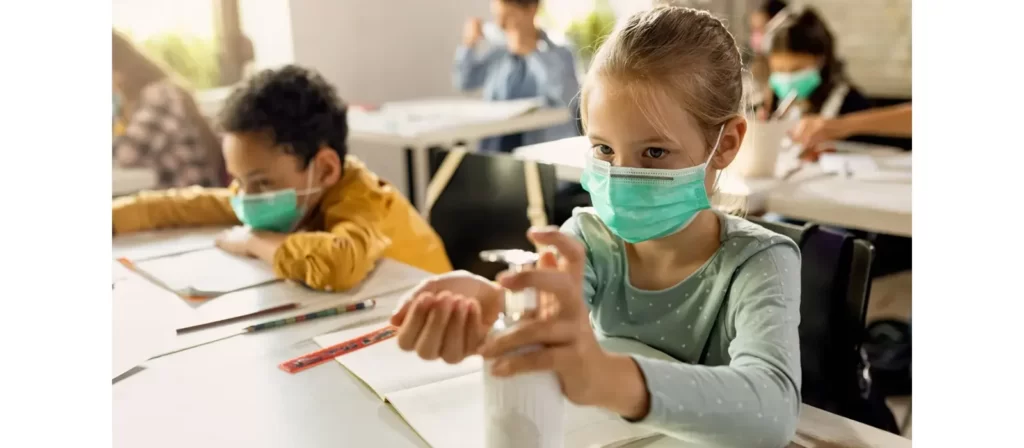
Classrooms need to be maintained in a clean and sanitary environment. This includes stocking cleaning supplies such as sanitizing wipes, hand sanitizer, paper towels and safe cleaning sprays.
Choose child-safe cleaning products and store them safely out of children’s reach. Involving children in simple cleaning routines can teach them hygiene and responsibility, using safe and appropriate tools such as small brooms or trash cans.
7. Age-Appropriate Toys

Toys in kindergarten classroom should be chosen for their educational value and age appropriateness. Classic toys such as blocks, puzzles, dolls, and pretend play sets are great for stimulating creativity and cognitive development. It is important to have a variety of toys to cater to different interests and abilities.
8. Art Tools
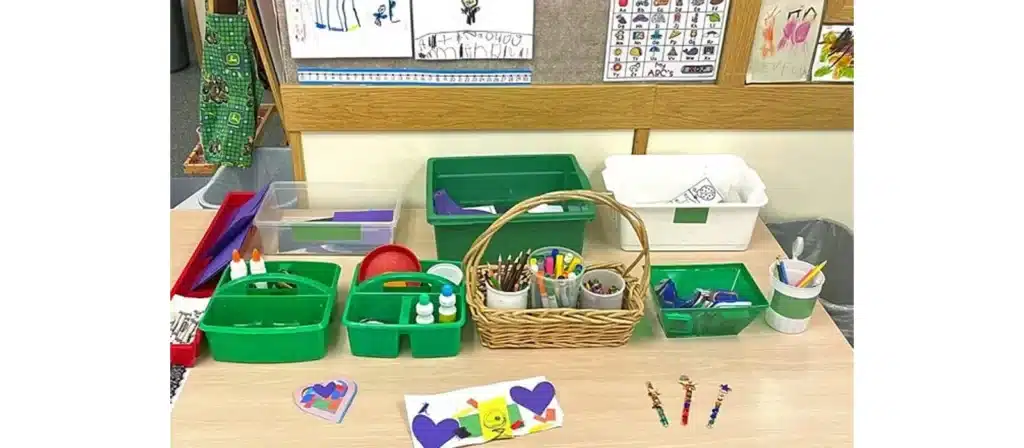
Art tools include a range of supplies such as crayons, markers, paint, brushes, scissors and glue. Providing a variety and quality of art materials encourages children to explore their creativity.
9.Exercise Equipment
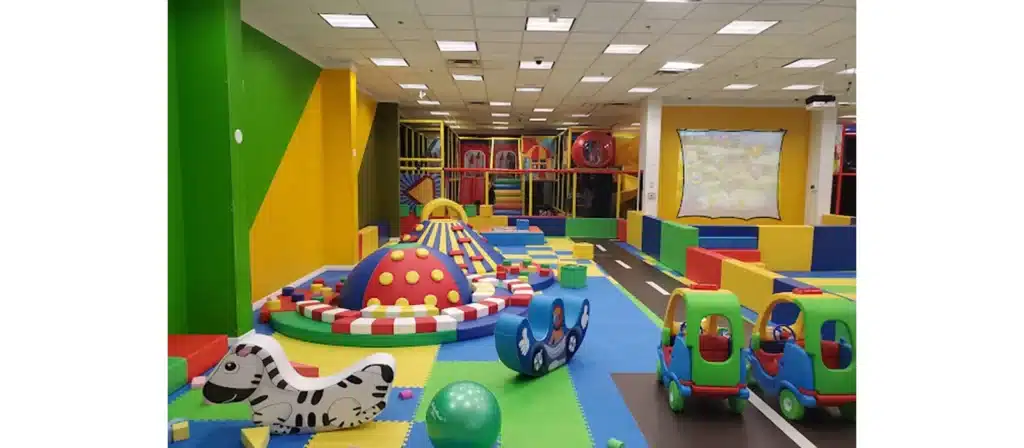
Physical activity promotes physical fitness, coordination and motor skills. Incorporate exercise equipment such as small balls, jump ropes, rings and balance beams.
Create a designated play area, indoors or outdoors, to ensure that children have a safe space to exercise. This area should be equipped with mats for safety and comfort.
10.Books
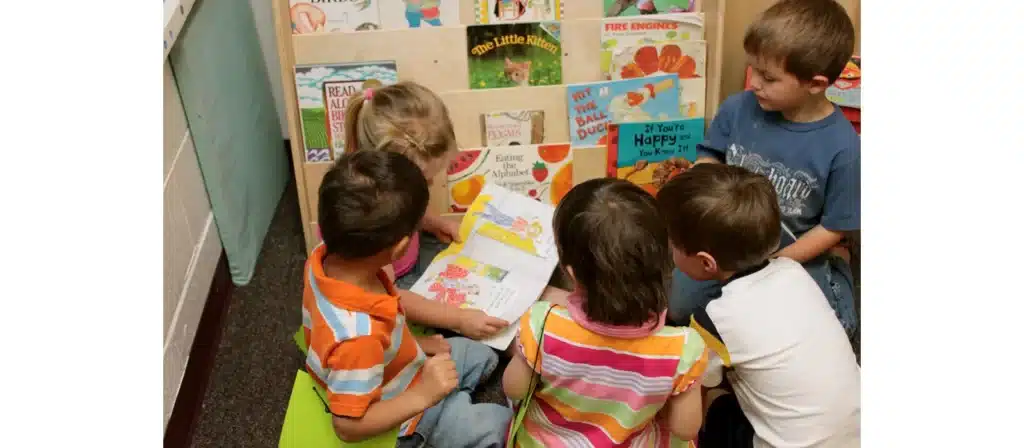
A diverse book collection is the foundation of the kindergarten classroom. This includes picture books, early readers, storybooks, and informational books covering a wide range of topics and interests. Displayed on low shelves or placed where children can easily see and choose what they want to read. Create a comfortable and inviting reading area with soft seating to encourage children to spend time reading and exploring books.
11. Spare Clothes

Spare clothing is stocked in kindergarten classroom to be used as replacements when children soil their clothes. This includes items such as shirts, pants, socks and underwear to meet the needs of young children. Parents can be encouraged to provide a spare set of clothes for their child to keep at school in case of emergency, ensuring that they are the right size and familiar to the child.
12. Small Houseplants

Easy-to-care-for plants like succulents or spider plants are suitable choices.Involving children in plant care, such as watering or cleaning leaves, can be an educational activity. It instills a sense of responsibility and provides hands-on experience in observing growth and change.
13. Children’s Stationery

Children’s stationery includes child-safe scissors, large crayons, washable markers and glue sticks. Providing a variety of stationery caters to different activities and developmental stages. Using containers, trays or labeled drawers helps keep stationery organized.
14. Kindergarten Classroom Outdoor Equipment

Outdoor equipment extends learning beyond the classroom. This includes playground structures such as slides, swings and climbing frames, as well as outdoor learning tools such as gardening equipment or outdoor science kits.
Safety is a primary concern for outdoor equipment. Regular inspections and maintenance should be performed to ensure that all equipment is safe and in good working order.
Incorporating natural elements and diverse play opportunities in outdoor spaces encourages exploration, physical activity, and connection to nature.
Decorating a Kindergarten Classroom
Once the layout of the classroom and some of the essentials for the kindergarten classroom have been chosen, we are ready to start decorating the classroom.
Choosing a theme, wall decorations, and selecting appropriate lighting and curtains play a significant role in shaping the classroom’s atmosphere and functionality.
Theme Selection
The theme of the classroom sets the tone for both learning and play. It should be engaging, educational, and age-appropriate. When choosing a theme, consider interests that resonate with young children, such as nature, space, or storybook characters. The theme should inspire imagination and curiosity, fostering a love for learning.
- Incorporate Educational Elements: The theme should have educational components. For instance, a nature theme can include elements of different animals and plants, teaching children about the environment.
- Cultural Sensitivity and Inclusivity: Ensure the theme is culturally sensitive and inclusive, representing various backgrounds and experiences.
- Flexibility: The theme should be flexible enough to incorporate various educational materials and seasonal changes throughout the year.
Wall Decorations

Walls in a kindergarten classroom are not just structural elements but canvases for learning and creativity. Effective wall decorations can significantly enhance the learning experience.
- Educational Posters: Use posters that are visually stimulating and educational. Alphabet posters, number charts, and world maps are excellent choices.
- Interactive Elements: Consider adding interactive wall elements like felt boards or magnetic boards, where children can engage in hands-on learning activities.
- Art Display: Dedicate space for displaying children’s artwork. This not only decorates the room but also instills a sense of pride and achievement in the children.
- Themes and Colors: Ensure the wall decorations align with the chosen theme. Use colors that are vibrant yet not overstimulating, maintaining a balance that fosters concentration and relaxation.
Lighting and Curtains Selection
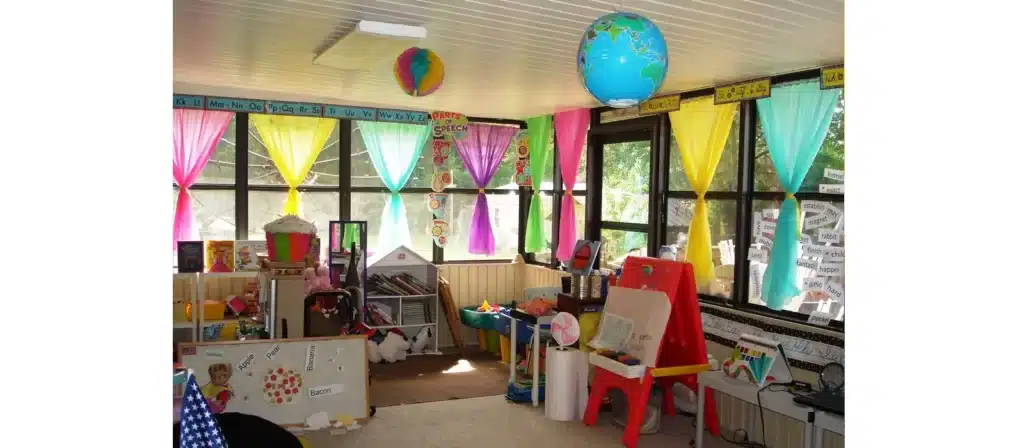
- Natural Light: Maximize natural light as it is beneficial for children’s health and concentration. Use window placements effectively to illuminate the classroom.
- Lighting Fixtures: Choose lighting fixtures that provide ample, even light. Avoid harsh lighting that can cause discomfort. Consider using LED lights that are energy-efficient and emit less heat.
- Curtains: Select curtains that complement the classroom theme. They should be functional, allowing control of light and providing privacy when necessary. Opt for materials that are safe and easy to clean.
- Safety and Accessibility: Ensure that all lighting and curtain fixtures are safe and out of reach of children to prevent accidents.
How to Manage a Kindergarten Classroom?
- Establishing Routines: Consistent routines help children feel secure and understand what’s expected of them. This includes daily schedules for activities, snack time, and nap time.
- Behavior Management: Establish clear, age-appropriate rules. Use positive reinforcement to encourage good behavior and have a plan in place for handling challenging behaviors.
- Engagement Strategies: Keep children engaged with a variety of activities. Use interactive teaching methods and hands-on learning to maintain their interest and encourage participation.
- Communication: Open lines of communication with children and parents. Regular updates, parent-teacher meetings, and involving parents in classroom activities can foster a strong community.
- Professional Development: Continuously educate yourself on the latest teaching strategies and child development theories. Attend workshops, seminars, and engage in peer learning.
Conclusion
In conclusion, crafting a comprehensive kindergarten classroom involves meticulous planning, a deep understanding of child development, and a passion for teaching. With this guide, I aim to provide valuable insights for creating an environment where children can thrive and grow. Remember, each child’s journey is unique, and as educators, our role is to nurture and guide them on this path of discovery.

